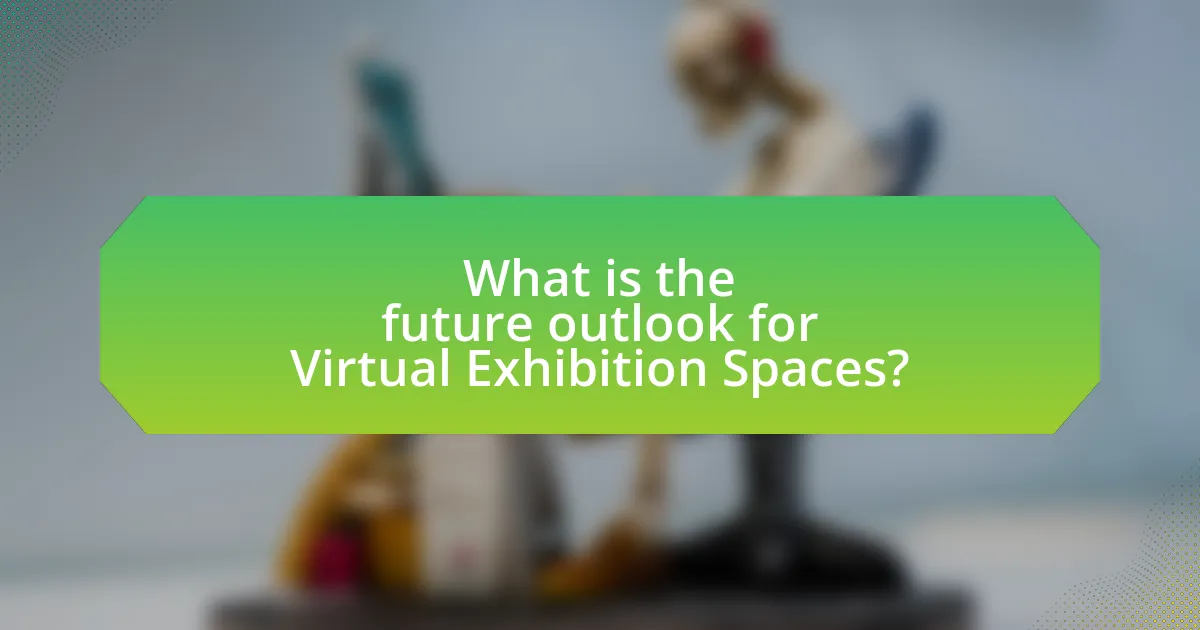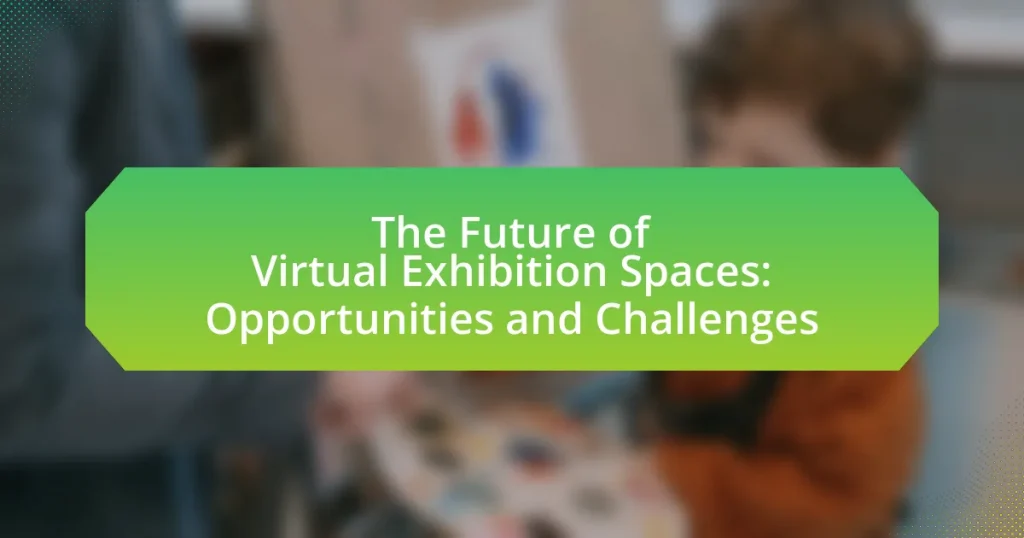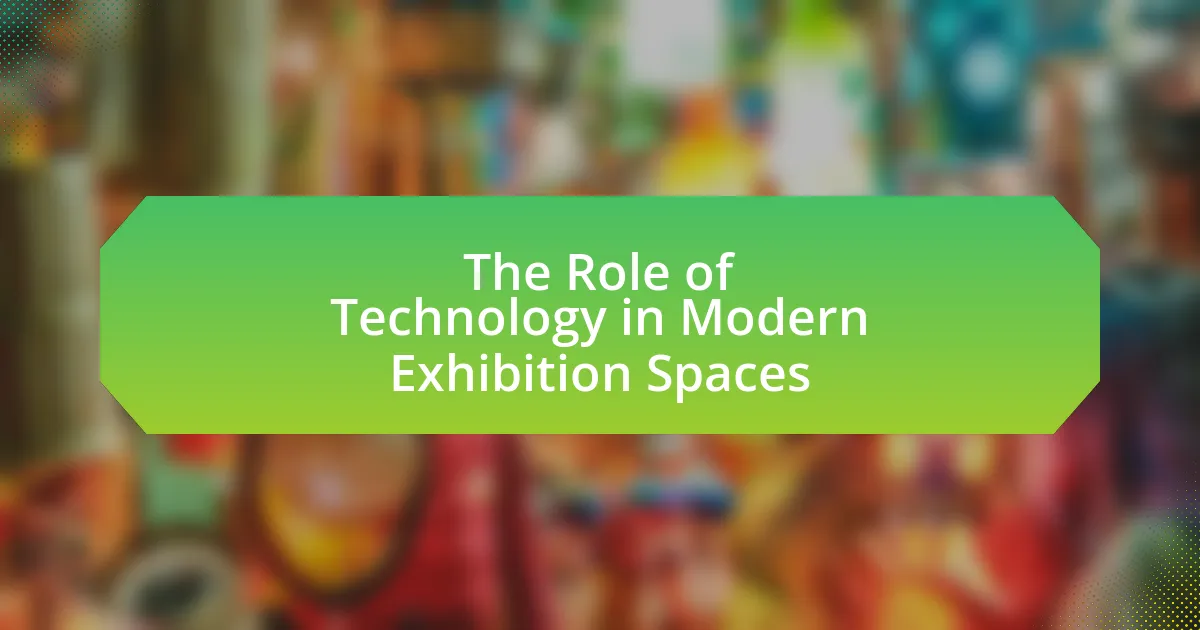Virtual Exhibition Spaces are digital platforms that facilitate exhibitions, allowing global participation through advanced technologies such as virtual reality, augmented reality, and 3D modeling. This article explores the differences between virtual and traditional exhibitions, highlighting the accessibility, interactivity, and cost-effectiveness of virtual spaces. It discusses the technologies that enable these platforms, their key features, and the growing popularity driven by the demand for remote engagement. Additionally, the article addresses the challenges faced by virtual exhibitions, including technological limitations and user engagement issues, while also examining the future outlook and potential of these spaces in various industries.

What are Virtual Exhibition Spaces?
Virtual Exhibition Spaces are digital platforms designed to host exhibitions, allowing participants to showcase products, services, or art in a virtual environment. These spaces utilize technologies such as 3D modeling, virtual reality, and interactive features to create immersive experiences for attendees, enabling them to explore exhibits from anywhere in the world. The rise of Virtual Exhibition Spaces has been driven by advancements in technology and the increasing demand for remote engagement, particularly highlighted during the COVID-19 pandemic when physical events were restricted. According to a report by Statista, the global virtual events market is projected to reach $404 billion by 2027, underscoring the growing significance of these platforms in the event industry.
How do Virtual Exhibition Spaces differ from traditional exhibitions?
Virtual exhibition spaces differ from traditional exhibitions primarily in their accessibility and interactivity. Virtual exhibitions allow participants to access content from anywhere in the world, eliminating geographical barriers, while traditional exhibitions require physical presence at a specific location. Additionally, virtual spaces often incorporate interactive elements such as 3D models, videos, and live chats, enhancing user engagement compared to the static displays typically found in traditional settings. This shift towards digital platforms has been accelerated by advancements in technology and the increasing demand for remote participation, as evidenced by the rise in virtual events during the COVID-19 pandemic, which saw a 100% increase in online exhibitions according to a report by Eventbrite.
What technologies enable Virtual Exhibition Spaces?
Virtual Exhibition Spaces are enabled by technologies such as virtual reality (VR), augmented reality (AR), 3D modeling, and web-based platforms. VR immerses users in a fully interactive environment, while AR overlays digital information onto the physical world, enhancing user engagement. 3D modeling allows for the creation of realistic representations of exhibits, facilitating a more engaging experience. Web-based platforms provide accessibility, enabling users to participate from anywhere with an internet connection. These technologies collectively enhance the interactivity and accessibility of virtual exhibitions, making them a viable alternative to traditional physical spaces.
What are the key features of Virtual Exhibition Spaces?
Virtual Exhibition Spaces are characterized by interactivity, accessibility, customization, and analytics. Interactivity allows users to engage with exhibits through features like live chats, Q&A sessions, and virtual tours, enhancing user experience. Accessibility ensures that participants can join from anywhere in the world, breaking geographical barriers and increasing attendance. Customization enables exhibitors to design their virtual booths according to their branding and messaging, providing a tailored experience for visitors. Analytics tools track user engagement and behavior, offering insights that help organizers and exhibitors improve future events. These features collectively enhance the effectiveness and reach of virtual exhibitions compared to traditional formats.
Why are Virtual Exhibition Spaces gaining popularity?
Virtual Exhibition Spaces are gaining popularity due to their ability to provide accessible, cost-effective, and immersive experiences for both exhibitors and attendees. These platforms eliminate geographical barriers, allowing participants from around the world to engage without the need for travel, which has become increasingly important in a globalized economy. According to a report by Statista, the virtual events market is projected to grow to $404 billion by 2027, highlighting the increasing demand for such spaces. Additionally, virtual exhibitions offer innovative features like interactive booths, real-time analytics, and networking opportunities, enhancing user engagement and satisfaction.
What advantages do Virtual Exhibition Spaces offer to exhibitors?
Virtual Exhibition Spaces provide exhibitors with enhanced reach and cost-effectiveness. These platforms allow exhibitors to connect with a global audience without the geographical limitations of traditional exhibitions, significantly increasing potential visitor numbers. Additionally, the operational costs associated with physical venues, such as travel, accommodation, and logistics, are eliminated, making participation more financially viable. According to a report by the Event Marketing Institute, 70% of marketers believe that virtual events can reach a broader audience compared to in-person events, validating the effectiveness of virtual spaces in maximizing exposure for exhibitors.
How do attendees benefit from Virtual Exhibition Spaces?
Attendees benefit from Virtual Exhibition Spaces by gaining access to a wider range of exhibitors and products without geographical limitations. This format allows participants to explore diverse offerings from various industries, enhancing their networking opportunities and knowledge acquisition. According to a report by Event Marketer, 70% of attendees at virtual events reported discovering new products and services that they would not have encountered at traditional exhibitions. Additionally, virtual spaces often provide interactive features such as live chats and webinars, which facilitate real-time engagement with industry experts and peers, further enriching the attendee experience.

What opportunities do Virtual Exhibition Spaces present?
Virtual Exhibition Spaces present opportunities for increased accessibility, enhanced engagement, and cost-effectiveness. These platforms allow participants from diverse geographical locations to attend exhibitions without the constraints of travel, thereby broadening the audience reach. For instance, a study by the International Association of Exhibitions and Events found that virtual events can attract up to 10 times more attendees than traditional in-person events. Additionally, virtual spaces enable interactive features such as live chats, webinars, and immersive experiences, which can significantly enhance participant engagement. Furthermore, the reduced overhead costs associated with virtual exhibitions, such as venue rental and logistics, make them a financially viable option for organizers, allowing for more resources to be allocated towards marketing and content creation.
How can businesses leverage Virtual Exhibition Spaces for marketing?
Businesses can leverage Virtual Exhibition Spaces for marketing by creating immersive experiences that engage potential customers and showcase products effectively. These platforms allow businesses to reach a global audience without geographical limitations, enhancing visibility and brand awareness. For instance, a study by Statista indicates that 70% of marketers believe virtual events are effective for lead generation. Additionally, businesses can utilize interactive features such as live chats, webinars, and virtual product demonstrations to foster real-time engagement, which can lead to higher conversion rates. By analyzing attendee data and behavior within these spaces, companies can tailor their marketing strategies to better meet customer needs, further validating the effectiveness of virtual exhibitions in driving sales and brand loyalty.
What innovative engagement strategies can be used in Virtual Exhibition Spaces?
Innovative engagement strategies in Virtual Exhibition Spaces include interactive 3D environments, live streaming presentations, and gamification elements. Interactive 3D environments allow attendees to navigate virtual spaces as if they were in a physical exhibition, enhancing immersion and engagement. Live streaming presentations enable real-time interaction between speakers and attendees, fostering a sense of community and immediacy. Gamification elements, such as quizzes and rewards for participation, increase user engagement by making the experience more enjoyable and competitive. These strategies have been shown to improve attendee satisfaction and retention rates, as evidenced by a study from the Virtual Events Institute, which reported that 70% of participants felt more engaged in events that utilized these innovative approaches.
How can data analytics enhance the effectiveness of Virtual Exhibition Spaces?
Data analytics can enhance the effectiveness of Virtual Exhibition Spaces by providing insights into user behavior and engagement patterns. By analyzing data such as visitor interactions, dwell time, and content preferences, organizers can tailor the exhibition experience to meet the specific needs and interests of attendees. For instance, a study by the Event Marketing Institute found that 70% of event marketers believe data analytics significantly improves attendee engagement. This data-driven approach allows for real-time adjustments to the exhibition layout and content, ultimately leading to higher satisfaction rates and increased participation.
What new markets can be accessed through Virtual Exhibition Spaces?
Virtual Exhibition Spaces can access new markets such as international audiences, niche industries, and remote participants. These platforms eliminate geographical barriers, allowing businesses to showcase products and services to a global audience, which is evidenced by the increase in virtual events during the COVID-19 pandemic, where companies reported reaching attendees from diverse locations that would have been logistically challenging in physical settings. Additionally, niche markets, such as specialized technology sectors or unique art communities, benefit from targeted virtual exhibitions that cater specifically to their interests, enhancing engagement and participation. Remote participants, who may lack the resources to attend traditional exhibitions, can now access these spaces, broadening the market reach for exhibitors and creating opportunities for new customer interactions.
How do Virtual Exhibition Spaces facilitate global reach?
Virtual Exhibition Spaces facilitate global reach by enabling participants from diverse geographical locations to engage simultaneously without the constraints of physical distance. These platforms utilize advanced technology to host interactive displays, live presentations, and networking opportunities, allowing exhibitors to showcase their products and services to a worldwide audience. For instance, a report by Statista indicates that the global virtual events market is projected to grow significantly, highlighting the increasing adoption of such spaces for international outreach. This accessibility not only broadens the audience base but also enhances collaboration and knowledge sharing across borders, making it easier for businesses to connect with potential clients and partners globally.
What niche industries can benefit from Virtual Exhibition Spaces?
Niche industries that can benefit from Virtual Exhibition Spaces include technology, healthcare, education, and art. The technology sector can showcase innovations and products to a global audience, enhancing reach and engagement. Healthcare can utilize virtual spaces for medical conferences and product demonstrations, allowing for wider participation without geographical constraints. The education industry can host virtual fairs and workshops, making learning resources accessible to a broader demographic. The art sector can exhibit works to international audiences, facilitating sales and exposure without the limitations of physical galleries. These industries leverage virtual exhibition spaces to enhance visibility, reduce costs, and increase accessibility.

What challenges do Virtual Exhibition Spaces face?
Virtual exhibition spaces face several challenges, including technological limitations, user engagement, and accessibility issues. Technological limitations can hinder the quality of virtual experiences, as inadequate bandwidth or outdated devices may prevent users from fully engaging with the content. User engagement is another significant challenge; maintaining attention in a virtual environment is difficult, as distractions are prevalent and users may not feel the same level of immersion as in physical exhibitions. Accessibility issues also arise, as not all users have equal access to the necessary technology or internet connectivity, which can exclude certain demographics from participating. These challenges highlight the need for continuous improvement in technology and design to enhance the effectiveness of virtual exhibition spaces.
What technical issues can arise in Virtual Exhibition Spaces?
Technical issues that can arise in Virtual Exhibition Spaces include connectivity problems, software compatibility issues, and user interface challenges. Connectivity problems can lead to lag or disconnection, affecting user experience and engagement. Software compatibility issues may arise when different platforms or devices do not support the same features, limiting accessibility for users. User interface challenges can result in confusion or difficulty navigating the virtual environment, which can deter participation. These issues are supported by studies indicating that 30% of users experience connectivity issues during virtual events, and 25% report difficulties with navigation and usability in virtual spaces.
How can connectivity and platform reliability impact user experience?
Connectivity and platform reliability significantly enhance user experience by ensuring seamless access to virtual exhibition spaces. High connectivity allows users to engage with content without interruptions, while reliable platforms minimize downtime and technical issues. Research indicates that 75% of users expect a consistent experience across devices, and any disruption can lead to frustration and disengagement. Furthermore, a study by Akamai found that a 100-millisecond delay in load time can decrease conversion rates by 7%. Therefore, robust connectivity and reliability are essential for maintaining user satisfaction and engagement in virtual environments.
What security concerns are associated with Virtual Exhibition Spaces?
Security concerns associated with Virtual Exhibition Spaces include data breaches, unauthorized access, and user privacy violations. These platforms often handle sensitive information, such as personal data and payment details, making them attractive targets for cybercriminals. For instance, a report by Cybersecurity Ventures predicts that cybercrime will cost the world $10.5 trillion annually by 2025, highlighting the increasing threat landscape. Additionally, inadequate security measures can lead to unauthorized access, where malicious actors exploit vulnerabilities to disrupt events or steal information. Furthermore, user privacy is at risk if proper data protection protocols are not implemented, potentially leading to identity theft or misuse of personal information.
How do user experience and engagement present challenges?
User experience and engagement present challenges primarily through the difficulty in creating intuitive interfaces that meet diverse user needs. In virtual exhibition spaces, users often encounter navigation issues, leading to frustration and disengagement. Research indicates that 70% of users abandon a website due to poor usability, highlighting the critical need for seamless interactions. Additionally, maintaining user interest over time is challenging; studies show that 55% of users lose interest after a few minutes if content is not engaging. These statistics underscore the importance of designing user-centric experiences that foster sustained engagement in virtual environments.
What factors influence attendee engagement in Virtual Exhibition Spaces?
Attendee engagement in Virtual Exhibition Spaces is influenced by several key factors, including interactivity, content quality, networking opportunities, and user experience design. Interactivity, such as live Q&A sessions and virtual tours, enhances participation and keeps attendees involved. High-quality content, including informative presentations and engaging multimedia, captures attention and encourages deeper exploration. Networking opportunities, like chat rooms and virtual meetups, foster connections among attendees, increasing their investment in the event. Lastly, user experience design, which encompasses intuitive navigation and visually appealing layouts, significantly impacts how attendees interact with the platform. Research indicates that events with strong interactivity and user-centric design see up to 70% higher engagement rates compared to those lacking these elements.
How can exhibitors create immersive experiences in a virtual environment?
Exhibitors can create immersive experiences in a virtual environment by utilizing advanced technologies such as virtual reality (VR), augmented reality (AR), and interactive multimedia content. These technologies allow exhibitors to design engaging and interactive displays that simulate real-world experiences, enhancing user engagement and retention. For instance, a study by PwC found that VR can increase information retention by up to 75% compared to traditional methods. Additionally, incorporating gamification elements, such as interactive quizzes or challenges, can further captivate audiences and encourage participation. By leveraging these tools, exhibitors can transform standard presentations into dynamic, memorable experiences that resonate with attendees.

What is the future outlook for Virtual Exhibition Spaces?
The future outlook for Virtual Exhibition Spaces is highly promising, driven by advancements in technology and increasing acceptance of digital platforms. As of 2023, the global virtual events market is projected to reach $404 billion by 2027, indicating a significant shift towards online engagement. This growth is fueled by the need for businesses to reach wider audiences and reduce costs associated with physical events. Enhanced features such as immersive experiences through augmented reality (AR) and virtual reality (VR) are expected to further elevate user engagement. Additionally, the COVID-19 pandemic has accelerated the adoption of virtual spaces, establishing a new norm for exhibitions and trade shows.
How will emerging technologies shape Virtual Exhibition Spaces?
Emerging technologies will significantly shape Virtual Exhibition Spaces by enhancing interactivity, personalization, and accessibility. Technologies such as virtual reality (VR), augmented reality (AR), and artificial intelligence (AI) will create immersive experiences that allow users to engage with exhibits in innovative ways. For instance, VR can transport users to a fully interactive environment, while AR can overlay digital information onto physical spaces, enriching the visitor experience. Additionally, AI can analyze user behavior to tailor content and recommendations, making exhibitions more relevant to individual preferences. According to a report by the International Data Corporation, the global AR and VR market is expected to reach $198 billion by 2025, indicating a strong trend towards these technologies in various sectors, including exhibitions.
What role will virtual reality and augmented reality play in future exhibitions?
Virtual reality (VR) and augmented reality (AR) will play a transformative role in future exhibitions by enhancing visitor engagement and creating immersive experiences. These technologies allow exhibitors to present content in interactive formats, enabling attendees to explore exhibits in a more dynamic way. For instance, VR can transport users to virtual environments that replicate real-world locations or historical events, while AR can overlay digital information onto physical displays, enriching the context of the exhibits. Research indicates that 70% of consumers believe that AR can enhance their shopping experience, suggesting a strong potential for similar applications in exhibitions. By integrating VR and AR, future exhibitions can offer personalized experiences, increase accessibility, and provide innovative storytelling methods, ultimately reshaping how audiences interact with art, culture, and information.
How might artificial intelligence enhance Virtual Exhibition Spaces?
Artificial intelligence can enhance virtual exhibition spaces by providing personalized experiences for users. AI algorithms analyze user behavior and preferences, allowing for tailored content recommendations and interactive features that engage visitors more effectively. For instance, AI-driven chatbots can offer real-time assistance, answering questions and guiding users through exhibits, which improves user satisfaction and retention. Additionally, AI can optimize the layout and design of virtual spaces based on user interaction data, ensuring that the most popular exhibits are easily accessible. Studies show that personalized experiences can increase user engagement by up to 50%, demonstrating the significant impact of AI on enhancing virtual exhibition spaces.
What best practices should be adopted for successful Virtual Exhibition Spaces?
Successful virtual exhibition spaces should adopt best practices such as user-friendly navigation, engaging content, and effective networking opportunities. User-friendly navigation ensures that attendees can easily explore the exhibition without confusion, which is supported by studies indicating that intuitive interfaces increase user satisfaction and retention. Engaging content, including interactive elements like videos and live demonstrations, captures attention and enhances the overall experience, as research shows that interactive content can lead to a 70% increase in engagement compared to static content. Lastly, providing effective networking opportunities, such as chat rooms and virtual meet-ups, fosters connections among participants, which is crucial for the success of any exhibition, as networking is often cited as a primary reason for attending events.
How can exhibitors optimize their presence in Virtual Exhibition Spaces?
Exhibitors can optimize their presence in Virtual Exhibition Spaces by utilizing interactive technologies, engaging content, and targeted marketing strategies. Interactive technologies, such as virtual reality and augmented reality, enhance user experience and allow for immersive product demonstrations. Engaging content, including live webinars and Q&A sessions, fosters real-time interaction with attendees, increasing interest and retention. Targeted marketing strategies, such as personalized email campaigns and social media promotions, ensure that the right audience is reached, maximizing visibility and engagement. According to a report by Event Marketer, 70% of attendees prefer interactive experiences, highlighting the importance of these strategies in driving attendee participation and satisfaction.
What strategies can enhance attendee satisfaction in Virtual Exhibition Spaces?
To enhance attendee satisfaction in Virtual Exhibition Spaces, implementing interactive features such as live Q&A sessions, networking opportunities, and gamification elements is essential. These strategies foster engagement and create a more immersive experience for attendees. Research indicates that events incorporating interactive elements see a 30% increase in attendee satisfaction compared to traditional formats, as participants feel more connected and involved. Additionally, providing personalized content and tailored recommendations based on attendee interests can significantly improve the overall experience, leading to higher retention rates and positive feedback.






